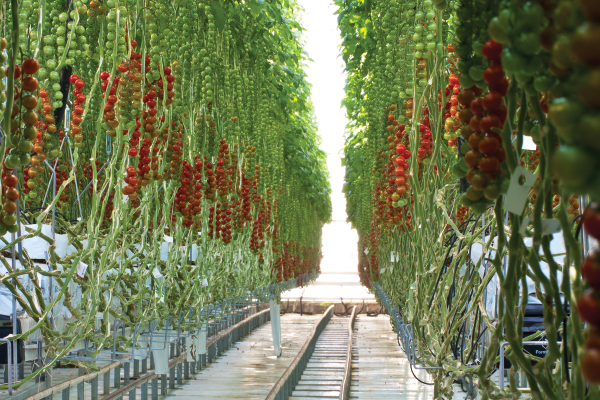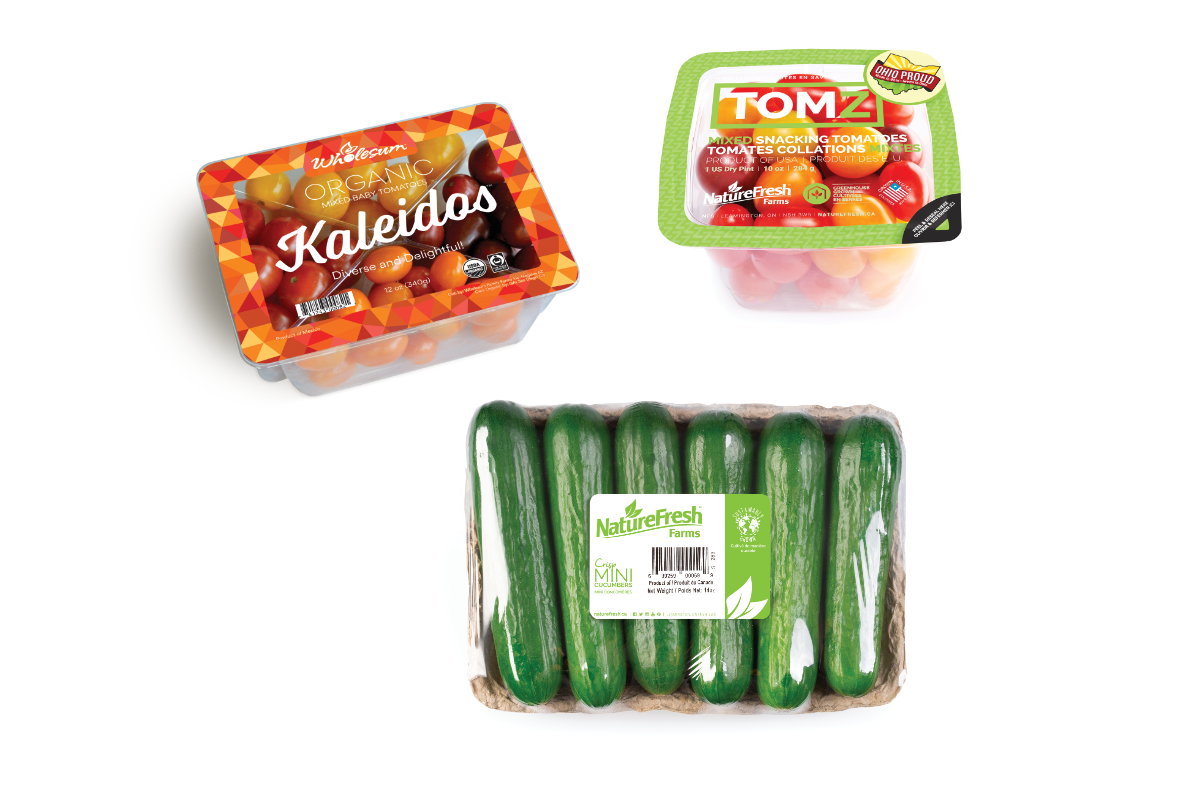Experimenting with new varieties and finding new ways to appeal to consumers’ desire for fresh, local and sustainable foods are among the trends greenhouse grower-shippers are keeping on top of in 2020.
Fiona McLean, marketing manager for DelFrescoPure, Kingsville, Ontario, Canada, said the company's growing season has been going great so far.
"We have a very nice crop this season," she said. "In particular, our heirloom tomatoes are doing so well that we have been able to double the program size. We are anticipating that all our commodities have a high yield this year."
Many greenhouse growers offer year-round production, including NatureFresh Farms, Leamington, Ontario, Canada, which has greenhouses in Leamington and Delta, Ohio.
"We are excited about our new spring production coming over the next six to eight weeks that will further enhance our local production with our continuous growing season and constant supply of product," said Ray Wowryk, director of business development for NatureFresh Farms.
Chris Veillon, chief marketing officer for Pure Hothouse Foods Inc., Leamington, which markets the Pure Flavor brand, said a family of growers who are strategically placed throughout North America allows the company to grow greenhouse tomatoes, cucumbers, peppers and organic versions of each year-round.
"We are successfully removing the seasonality of vegetables by growing in controlled environments like greenhouses," he added.
What's hot?
Mary-Scott DeMarchis, sales manager for Fresh2o Growers, a hydroponic greenhouse grower in Stevensburg, VA, which produces hydroponic head lettuces mostly, said the company is working on retail offerings of salad blends this year.
"Our most popular item is the green butter lettuce in a clamshell," she said. "We package our lettuce with the roots intact, so the product stays fresher and more nutritious than cut lettuces and field-grown lettuces without roots."
During the end of the winter season, McLean of DelFrescoPure said the company has been heavily promoting its YES!Berries.
"Our strawberries are available all year long, making sure the consumer always has outrageously sweet strawberries at the ready," she said. "We will also be pushing our heirloom tomatoes and Euro beans."
DelFrescoPure’s best-selling greenhouse vegetable is its bell pepper.
"Bell peppers are a staple in every home – not to mention delicious and nutritious," she said. "We offer red, yellow and orange peppers. The three-pack of sweet rainbow peppers and our bulk peppers have the largest amount of sales. In terms of what commodity we have that gets the most interest, our strawberries are always sold out!"
Joanna Jaramillo, marketing specialist for Wholesum Family Farms, Amado, Arizona, said the company has an "exquisite" assortment of heirloom tomatoes that were carefully selected for superior flavor and exceptional shelf life.
"Shelf life has often been the Achilles’ heel for heirlooms," she said. "That's why we spent the past year testing out many different varieties to select the very best to bring to market. Their unique shapes and colors also make them highly attractive for merchandising."
Aside from its heirloom tomatoes, Wholesum Family Farms is promoting its Flavor Lineup – a collection of high-flavor, organic snacking tomatoes in convenient, eye-catching top seal packaging, Jaramillo said.
"Each pack has a fun name and descriptor ranging from 'Poppies,' our sweet and snackable cherry tomatoes on the vine to 'Kaleidos,' our diverse and delightful mixed-color pack of snacking tomatoes," she added.
"This year, we will be moving production of our Valentinos to the U.S. We are also seeking to expand our supply of snacking tomatoes in response to the high market demands," Jaramillo continues.
Convenience, local, other trends

Wowryk of NatureFresh Farms said consumers continue to search for fresh local produce.
"Customers want fresher and more flavorful food and are also going more sustainable where they are becoming more conscious of packaging and noticing that local food means a lighter environmental footprint," he said. "We are able to meet these demands having greenhouses located near our customers in multiple locations allowing us to grow year-round."
Convenience food and products are also becoming more popular within the market as consumers want easy on-the-go meal solutions, Wowryk added.
"We are seeing an increase in demand for more snackable varieties and have successfully met those demands through our snacking lineups," he said.
DeMarchis of Fresh2o Growers agrees that sustainability and locally grown are consumer preferences that are driving growth.
"We ship lettuces on the East Coast, which is must closer than California or Arizona, where most of the country’s lettuce comes from," she said.
"We grow in a state-of-the-art greenhouse where we conserve 90% more water than field grown crops and have zero runoff and limited environmental impact," DeMarchis continues. "Our lettuce is also grown in a closed hydroponic system, so we offer cleaner lettuce with less safety concerns, as well."
Jaramillo of Wholesum Family Farms said she sees greenhouse trends of "going smaller" and more specialties.
"Smaller, portable vegetables like the cherry and grape tomatoes in our Flavor Lineup and our Persian cucumbers fulfill the need for convenience and on-the-go healthy, but delicious snacking," she said.
And regardless of the season, there continues to be increased demand year over year for greenhouse-grown tomatoes, said Veillon of Pure Hothouse Foods.
"The expansion of the tomato category over the last five to seven years has seen an explosion of brands and varieties for retailers and consumers alike to enjoy," he said. "With consistent quality, flavor and overall availability, consumers have become accustomed to enjoying fresh tomatoes year-round instead of just during typical summer months."
Growers are after the elusive varieties that not only have a great yield but that have a unique flavor profile that will separate them from the rest, Veillon said.
Pure Flavor spent several years in research and development to develop the new RedRoyals sweet cherry tomatoes on the vine. "The consistency of this product is second to none," he added.
Promotions: spell it out
Retailers can drive more sales of greenhouse vegetables by calling out "Greenhouse Grown" on in-store signage and explaining some of the qualities of greenhouse-grown produce, said Jaramillo of Wholesum Family Farms.
"Unless there is an immediate callout, knowing which produce items are greenhouse grown is not always very evident to consumers," she said.
Retailers can also highlight greenhouse-grown products when they are grown locally or closer to their market and they should also highlight if production is more sustainable, said DeMarchis of Fresh2o Growers.
"Also, greenhouse-grown products are grown consistently throughout the year," she said. "Consumers should know there is value in that consistency and quality that is produced through greenhouse growing."
DeMarchis said the company's greenhouse-grown lettuces sell well near the tomato displays or other salad items.
In regions where greenhouse-grown vegetables are a newer idea, Veillon of Pure Hothouse Foods said buy-one-get-one events have been successful in helping kick off an item.
"Key retail signage promoting flavor, availability and unique formats also help promote items in addition to product demos where people can 'try before they buy,'" he added. "We actively take part in consumer demos every year; the greatest barrier to cons umption is trial, and we have had fantastic success whenever we initiate sampling."
umption is trial, and we have had fantastic success whenever we initiate sampling."
Veillon went on to say that in the past, Pure Hothouse Foods' demo program has partnered with cheese and cracker companies to complement the fresh greenhouse-grown vegetables being promoted.
In addition to signage, McLean of DelFrescoPure said to best promote greenhouse commodities, retailers should implement more in-store training for managers and employees.
"Employee training allows the produce department to use creativity when designing the store layout," she said. "The more that consumers can see firsthand what we can offer, the better for us and the stores selling our commodities. Retailers could also increase the number of store-level merchandisers and demos that are captivating to the consumer."
McLean said there are a variety of cross-promotional items that would display well with greenhouse vegetables.
"Sauces, oils, lunch supplies and reusable bag options are just a few," she said. "They would help inspire the consumer to come up with creative recipes and be more conscious of their shopping habits."
Displays: the more, the merrier
When it comes to displaying greenhouse vegetables, McLean of DelFrescoPure said the more vegetables that can be featured and displayed properly at once, the better.
"Using esthetically designed displays, merchandisers and bins will also help attract consumers and encourage them to purchase the brand," she added.
Because greenhouse vegetables are so varied, Jaramillo of Wholesum Family Farms recommends using that contrast in colors, shapes and sizes in visually appealing displays to help promote them.
"They say people eat with their eyes, and such displays help attract and entice customers," she said. "It's also important to highlight quality and freshness by keeping displays clean, organized and stocked."
Finally, Veillon of Pure Hothouse Foods said making greenhouse-grown vegetables part of an existing product assortment ensures that the products are getting as much "face-time" as the rest of the items in the department.
"There quite often tends to be more greenhouse-grown vegetable options that come in a variety of pack formats and varieties, which can help liven up displays," he said. "Great product variety will be available due to greenhouse growing; it's a win-win for everyone."
